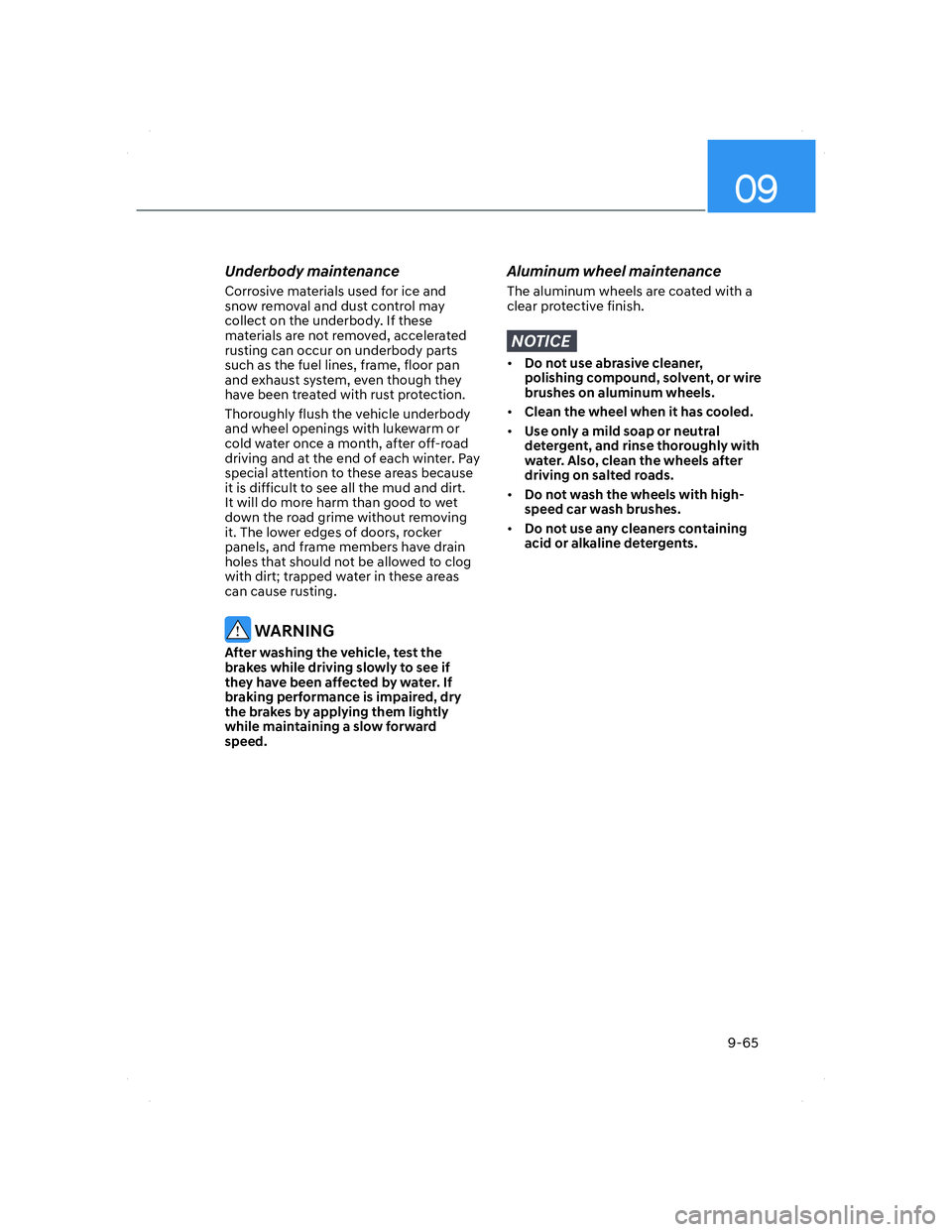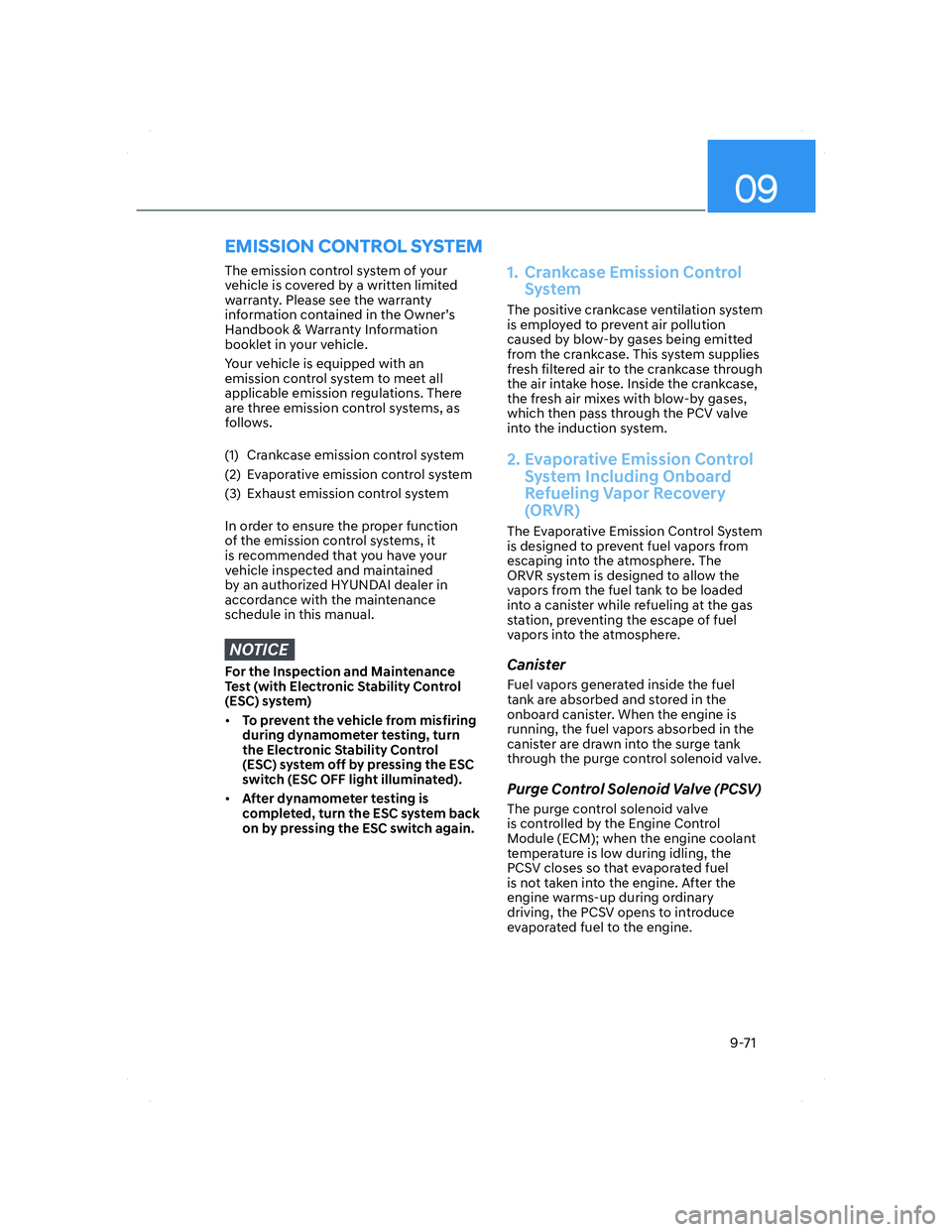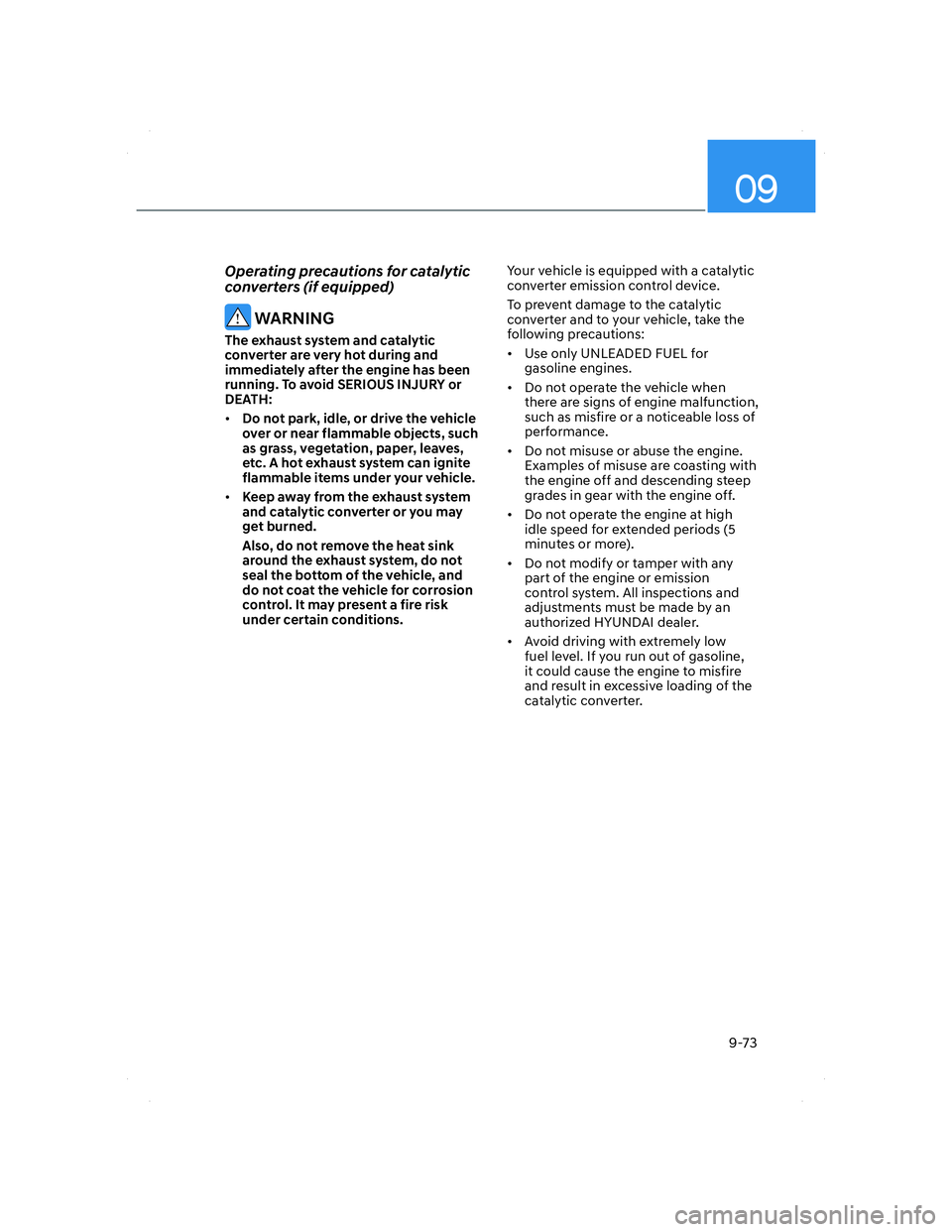2022 HYUNDAI ELANTRA fuel
[x] Cancel search: fuelPage 562 of 584

09
9-65
Underbody maintenance
Corrosive materials used for ice and
snow removal and dust control may
collect on the underbody. If these
materials are not removed, accelerated
rusting can occur on underbody parts
such as the fuel lines, frame, floor pan
and exhaust system, even though they
have been treated with rust protection.
Thoroughly flush the vehicle underbody
and wheel openings with lukewarm or
cold water once a month, after off-road
driving and at the end of each winter. Pay
special attention to these areas because
it is difficult to see all the mud and dirt.
It will do more harm than good to wet
down the road grime without removing
it. The lower edges of doors, rocker
panels, and frame members have drain
holes that should not be allowed to clog
with dirt; trapped water in these areas
can cause rusting.
WARNING
After washing the vehicle, test the
brakes while driving slowly to see if
they have been affected by water. If
braking performance is impaired, dry
the brakes by applying them lightly
while maintaining a slow forward
speed.
Aluminum wheel maintenance
The aluminum wheels are coated with a
clear protective finish.
NOTICE
• Do not use abrasive cleaner,
polishing compound, solvent, or wire
brushes on aluminum wheels.
• Clean the wheel when it has cooled.
• Use only a mild soap or neutral
detergent, and rinse thoroughly with
water. Also, clean the wheels after
driving on salted roads.
• Do not wash the wheels with high-
speed car wash brushes.
• Do not use any cleaners containing
acid or alkaline detergents.
CN7 HMA 9.indd 9-652020-12-03 9:42:38
Page 568 of 584

09
9-71
The emission control system of your
vehicle is covered by a written limited
warranty. Please see the warranty
information contained in the Owner’s
Handbook & Warranty Information
booklet in your vehicle.
Your vehicle is equipped with an
emission control system to meet all
applicable emission regulations. There
are three emission control systems, as
follows.
(1) Crankcase emission control system
(2) Evaporative emission control system
(3) Exhaust emission control system
In order to ensure the proper function
of the emission control systems, it
is recommended that you have your
vehicle inspected and maintained
by an authorized HYUNDAI dealer in
accordance with the maintenance
schedule in this manual.
NOTICE
For the Inspection and Maintenance
Test (with Electronic Stability Control
(ESC) system)
• To prevent the vehicle from misfiring
during dynamometer testing, turn
the Electronic Stability Control
(ESC) system off by pressing the ESC
switch (ESC OFF light illuminated).
• After dynamometer testing is
completed, turn the ESC system back
on by pressing the ESC switch again.
1. Crankcase Emission Control
System
The positive crankcase ventilation system
is employed to prevent air pollution
caused by blow-by gases being emitted
from the crankcase. This system supplies
fresh filtered air to the crankcase through
the air intake hose. Inside the crankcase,
the fresh air mixes with blow-by gases,
which then pass through the PCV valve
into the induction system.
2. Evaporative Emission Control
System Including Onboard
Refueling Vapor Recovery
(ORVR)
The Evaporative Emission Control System
is designed to prevent fuel vapors from
escaping into the atmosphere. The
ORVR system is designed to allow the
vapors from the fuel tank to be loaded
into a canister while refueling at the gas
station, preventing the escape of fuel
vapors into the atmosphere.
Canister
Fuel vapors generated inside the fuel
tank are absorbed and stored in the
onboard canister. When the engine is
running, the fuel vapors absorbed in the
canister are drawn into the surge tank
through the purge control solenoid valve.
Purge Control Solenoid Valve (PCSV)
The purge control solenoid valve
is controlled by the Engine Control
Module (ECM); when the engine coolant
temperature is low during idling, the
PCSV closes so that evaporated fuel
is not taken into the engine. After the
engine warms-up during ordinary
driving, the PCSV opens to introduce
evaporated fuel to the engine.
EMISSION CONTROL SYSTEM
CN7 HMA 9.indd 9-712020-12-03 9:42:38
Page 570 of 584

09
9-73
Operating precautions for catalytic
converters (if equipped)
WARNING
The exhaust system and catalytic
converter are very hot during and
immediately after the engine has been
running. To avoid SERIOUS INJURY or
DEATH:
• Do not park, idle, or drive the vehicle
over or near flammable objects, such
as grass, vegetation, paper, leaves,
etc. A hot exhaust system can ignite
flammable items under your vehicle.
• Keep away from the exhaust system
and catalytic converter or you may
get burned.
Also, do not remove the heat sink
around the exhaust system, do not
seal the bottom of the vehicle, and
do not coat the vehicle for corrosion
control. It may present a fire risk
under certain conditions.Your vehicle is equipped with a catalytic
converter emission control device.
To prevent damage to the catalytic
converter and to your vehicle, take the
following precautions:
• Use only UNLEADED FUEL for
gasoline engines.
• Do not operate the vehicle when
there are signs of engine malfunction,
such as misfire or a noticeable loss of
performance.
• Do not misuse or abuse the engine.
Examples of misuse are coasting with
the engine off and descending steep
grades in gear with the engine off.
• Do not operate the engine at high
idle speed for extended periods (5
minutes or more).
• Do not modify or tamper with any
part of the engine or emission
control system. All inspections and
adjustments must be made by an
authorized HYUNDAI dealer.
• Avoid driving with extremely low
fuel level. If you run out of gasoline,
it could cause the engine to misfire
and result in excessive loading of the
catalytic converter.
CN7 HMA 9.indd 9-732020-12-03 9:42:38
Page 576 of 584

I
I-5
E
Emission Control System .................................................................................... 9-71
Engine Compartment ..................................................................................... 2-8/ 9-3
Engine Coolant .................................................................................................... 9-17
Changing Engine Coolant ................................................................................ 9-19
Checking the Engine Coolant Level................................................................. 9-17
Engine Number .................................................................................................... 2-16
Engine Oil ............................................................................................................ 9-15
Checking the Engine Oil and Filter .................................................................. 9-16
Checking the Engine Oil Level ........................................................................ 9-15
Engine specification............................................................................................... 2-9
Explanation of Scheduled Maintenance Items .................................................... 9-13
Dual clutch transmission fluid ......................................................................... 9-14
Exterior Lights ..................................................................................................... 5-68
Battery saver function ...................................................................................... 5-71
Headlamp delay function ................................................................................. 5-71
High beam operation ........................................................................................ 5-69
Lighting control ................................................................................................ 5-68
Turn signals and lane change signals ............................................................... 5-70
Exterior Overview ................................................................................................. 2-2
F
Forward Collision–Avoidance Assist (FCA) (front view camera only) ............... 7-2
Function malfunction and limitations ................................................................ 7-7
Function operation.............................................................................................. 7-5
Function settings ................................................................................................ 7-3
Forward Collision–Avoidance Assist (FCA) (sensor fusion) ............................. 7-14
Function malfunction and limitations .............................................................. 7-22
Function operation............................................................................................ 7-18
Function settings .............................................................................................. 7-16
Fuel filler door ..................................................................................................... 5-66
Fuel Requirements ................................................................................................. 1-5
Detergent Fuel Additives.................................................................................... 1-7
Gasoline containing alcohol or methanol ........................................................... 1-6
Gasoline containing MMT ................................................................................. 1-6
Operation in foreign countries............................................................................ 1-7
Using Fuel Additives (except Detergent Fuel Additives)................................... 1-6